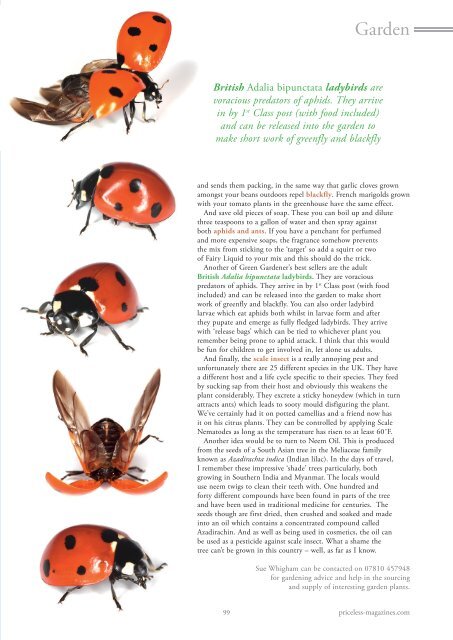Wealden Times | WT226 | March 2021 | Interiors supplement inside
Wealden Times - The lifestyle magazine for the Weald
Wealden Times - The lifestyle magazine for the Weald
Create successful ePaper yourself
Turn your PDF publications into a flip-book with our unique Google optimized e-Paper software.
Garden<br />
British Adalia bipunctata ladybirds are<br />
voracious predators of aphids. They arrive<br />
in by 1 st Class post (with food included)<br />
and can be released into the garden to<br />
make short work of greenfly and blackfly<br />
and sends them packing, in the same way that garlic cloves grown<br />
amongst your beans outdoors repel blackfly. French marigolds grown<br />
with your tomato plants in the greenhouse have the same effect.<br />
And save old pieces of soap. These you can boil up and dilute<br />
three teaspoons to a gallon of water and then spray against<br />
both aphids and ants. If you have a penchant for perfumed<br />
and more expensive soaps, the fragrance somehow prevents<br />
the mix from sticking to the ‘target’ so add a squirt or two<br />
of Fairy Liquid to your mix and this should do the trick.<br />
Another of Green Gardener’s best sellers are the adult<br />
British Adalia bipunctata ladybirds. They are voracious<br />
predators of aphids. They arrive in by 1 st Class post (with food<br />
included) and can be released into the garden to make short<br />
work of greenfly and blackfly. You can also order ladybird<br />
larvae which eat aphids both whilst in larvae form and after<br />
they pupate and emerge as fully fledged ladybirds. They arrive<br />
with ‘release bags’ which can be tied to whichever plant you<br />
remember being prone to aphid attack. I think that this would<br />
be fun for children to get involved in, let alone us adults.<br />
And finally, the scale insect is a really annoying pest and<br />
unfortunately there are 25 different species in the UK. They have<br />
a different host and a life cycle specific to their species. They feed<br />
by sucking sap from their host and obviously this weakens the<br />
plant considerably. They excrete a sticky honeydew (which in turn<br />
attracts ants) which leads to sooty mould disfiguring the plant.<br />
We’ve certainly had it on potted camellias and a friend now has<br />
it on his citrus plants. They can be controlled by applying Scale<br />
Nematodes as long as the temperature has risen to at least 60˚F.<br />
Another idea would be to turn to Neem Oil. This is produced<br />
from the seeds of a South Asian tree in the Meliaceae family<br />
known as Azadirachta indica (Indian lilac). In the days of travel,<br />
I remember these impressive ‘shade’ trees particularly, both<br />
growing in Southern India and Myanmar. The locals would<br />
use neem twigs to clean their teeth with. One hundred and<br />
forty different compounds have been found in parts of the tree<br />
and have been used in traditional medicine for centuries. The<br />
seeds though are first dried, then crushed and soaked and made<br />
into an oil which contains a concentrated compound called<br />
Azadirachin. And as well as being used in cosmetics, the oil can<br />
be used as a pesticide against scale insect. What a shame the<br />
tree can’t be grown in this country – well, as far as I know.<br />
Sue Whigham can be contacted on 07810 457948<br />
for gardening advice and help in the sourcing<br />
and supply of interesting garden plants.<br />
99 priceless-magazines.com


















